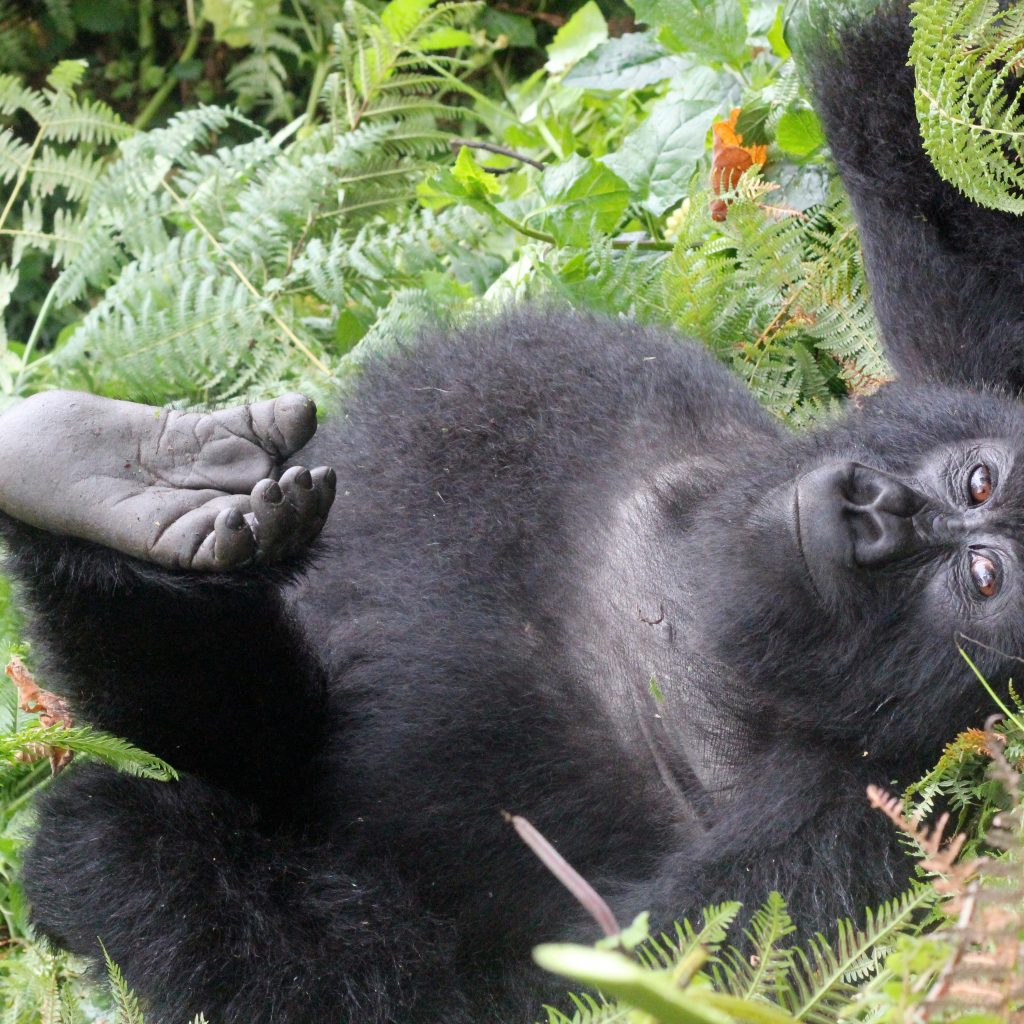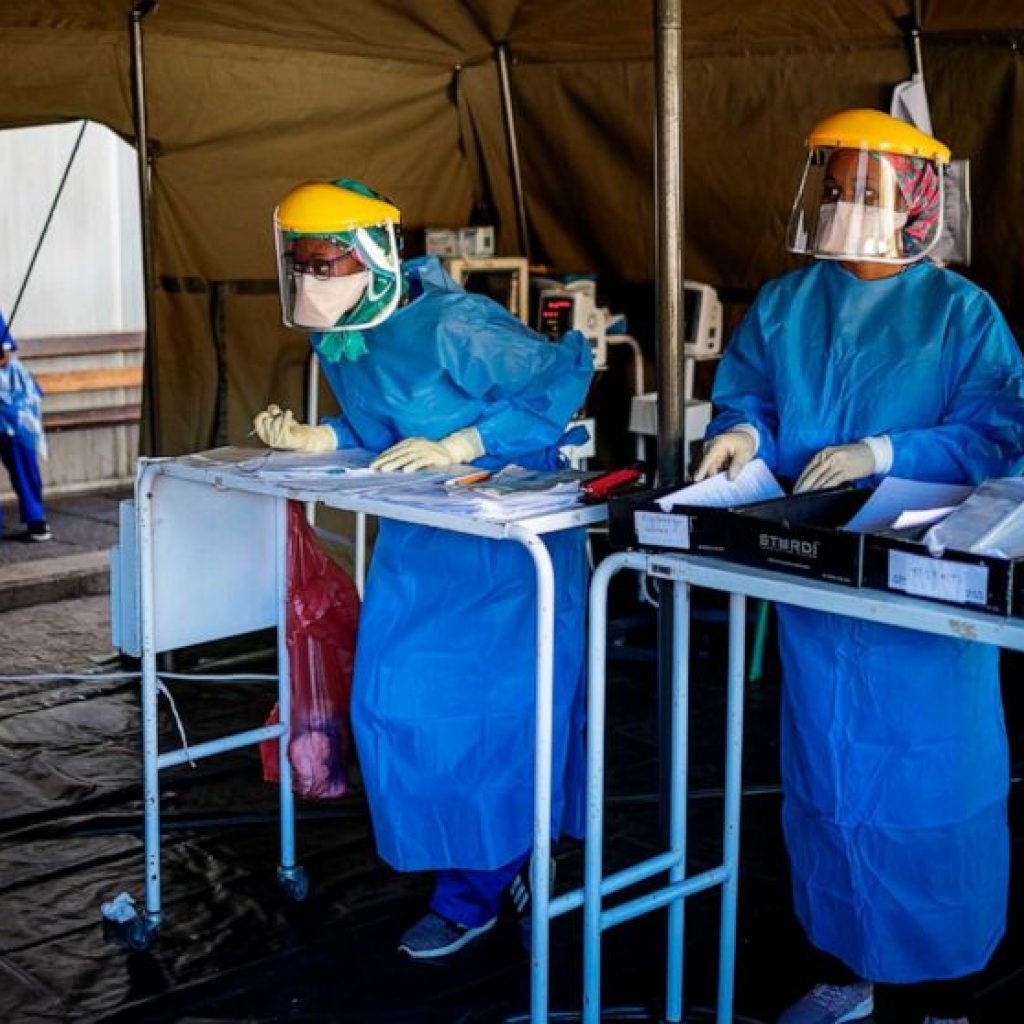
A recent survey documented 604 mountain gorillas (Gorilla beringei beringei), the largest number of mountain gorillas ever recorded in the transboundary Virunga Massif, one the two remaining areas where this critically endangered great ape is still found. When combined with the published figure of 400 mountain gorillas from Bwindi Impenetrable National Park, Uganda, as of 2011, an estimated 1,004 mountain gorillas existed in the wild as of June 2016(1).
In the area(2) encompassing the Mikeno Sector of Virunga National Park in the Democratic Republic of Congo, Volcanoes National Park in Rwanda, and Mgahinga Gorilla National Park in Uganda, referred to as the Virunga Massif, 604 individual gorillas were found in 41 groups and as 14 solitary males. This is compared with an estimated 480 individual gorillas in 36 groups and as 14 solitary males from a survey of the same area in 2010. As in the previous mountain gorilla census in 2010, survey teams walked pre-determined “recces” (reconnaissance trails) ensuring a thorough coverage of all forest areas to sweep the Virunga Massif from the southwest to northeast and search for signs of gorillas, other key mammals, and illegal activities. When fresh gorilla signs were detected, the teams followed the gorilla trail to locate three recent night nest sites. At each of these nest sites, the teams collected fecal samples from nests. However, during this past census in 2015-2016, the survey effort was doubled by sweeping the Virunga Massif twice; first from October to December 2015 (57 days) and second from March to May 2016 (59 days). A second sweep allows the team to find gorillas that were undetected during the first sweep and thus provides more reliable numbers of gorillas. Fecal samples were analyzed genetically to determine individual genotypes. The survey teams also collected data on signs and sightings of select mammals, such as elephants, and illegal activities, such as snares. While exercising caution due to the limitations of the study, there were no indications of declines in populations for the select mammals surveyed, including elephants, since 2010.
The survey was conducted by the Protected Area Authorities of DRC, Rwanda, and Uganda (l’Institut Congolais pour la Conservation de la Nature), the Rwanda Development Board and the Uganda Wildlife Authority, respectively) under the transboundary framework of the Greater Virunga Transboundary Collaboration(3), and supported by many partners and various donors(4). The increase in mountain gorillas inhabiting the Virunga Massif is attributed to the effectiveness of conservation policies, strategies, notably regulated tourism, daily protection and veterinary interventions, intensive law enforcement, community conservation projects, and transboundary collaboration among government institutions and NGO actors. Further, these results are a testament to the tireless effort of the rangers and trackers who daily protect and monitor mountain gorillas and their habitat, including those that have been killed in the line of duty.
It is also important to recognize the role of the communities that live in close proximity to these national parks who co-exist with mountain gorillas and contribute to conservation efforts. The two populations of mountain gorillas remain small and vulnerable to a potentially rapid decline due to factors such as their limited habitat, climate change, dependency on resources in the park by people, and the risk of disease transmission. The Greater Virunga Transboundary Collaboration calls upon all conservation institutions and organizations and in fact all individuals, to join efforts to conserve mountain gorillas and their habitat for future generations.
Contacts for media
1.ICCN/RDC : Virunga Press press@virunga.org
2.RDB/Rwanda : Sanny Ntayombya sanny.ntayombya@rdb.rw +250 722 123 408
3.UWA/Uganda : Bashir Hangi, bashir.hangi@ugandawildlife.org Communications Manager, Tele +256 772 446115
Done in Rubavu, on the 31st May 2018
Dr MUAMBA TSHIBASU Georges, Executive Secretary of GVTC
Notes to the editors:
(1) The reasons for the time lag between the survey and the publication of the results were due to the time needed to conduct the genetic analysis from faecal samples collected non-invasively from mountain gorilla night nest sites. The process of genetic analysis of the samples, while taking time, offers the most reliable results.
(2) The Virunga Massif is a 451 km2 area spanning the DRC, Rwanda and Uganda – including Mikeno Sector of Virunga National Park in DRC, Volcanoes National Park in Rwanda, and Mgahinga Gorilla National Park in Uganda – and is just one of two places on earth where mountain gorillas can still be found. The other is Bwindi Impenetrable National Park in Uganda, contiguous with Sarambwe Nature Reserve in DRC
(3) Institutional Information on GVTC : Initiated informally by the Park Managers to monitor the Migratory Mountain Gorillas between Democratic Republic of Congo (DRC), Rwanda and Uganda in 1990, the Greater Virunga Transboundary Collaboration has evolved since then into a Treaty signed between the three Partner States in October 2015 as framework of programmes, plans and activities to conserve a
network of transboundary Protected Areas in Greater Virunga Landscape (GVL) (4) The Virunga Massif mountain gorilla census was conducted by the Protected Area Authorities in the DRC, Rwanda, and
Uganda (l’Institut Congolais pour la Conservation de la Nature), the Rwanda Development Board and the Uganda Wildlife Authority) under the transboundary framework of the Greater
Virunga Transboundary Collaboration. The census was supported by the International Gorilla Conservation Programme (a coalition of Fauna & Flora International and WWF), Max Planck Institute for volutionary Anthropology, The Dian Fossey Gorilla Fund, Institute of Tropical Forest Conservation, Gorilla Doctors, and North Carolina Zoo. The census was funded by the three Partner States of the Greater Virunga Landscape and Fauna & Flora International, WWF, and Partners in Conservation at the Columbus Zoo & Aquarium. Additional financial support to the census science committee was provided by Berggorilla & Regenwald Direkthilfe.
(5) Over 175 rangers have sacrificed their lives protecting Virunga National Park in the last 20 years.




About The Author: Yvette De Vries
More posts by Yvette De Vries